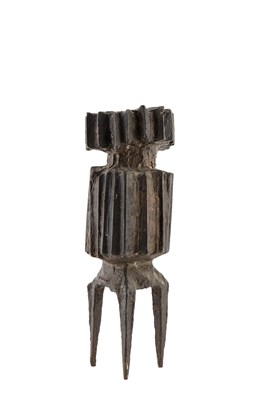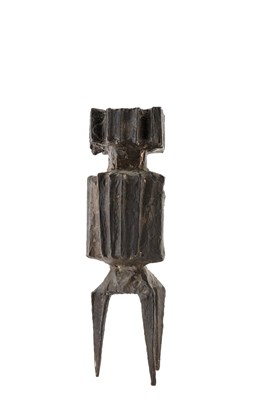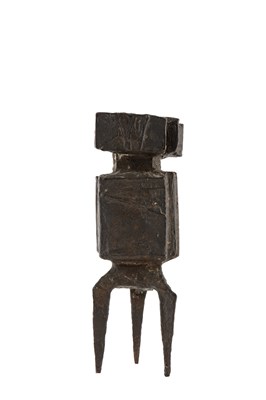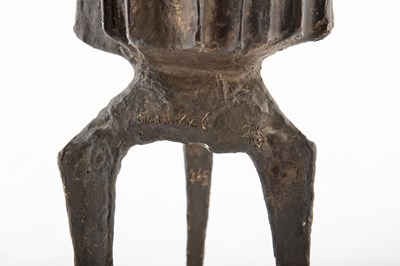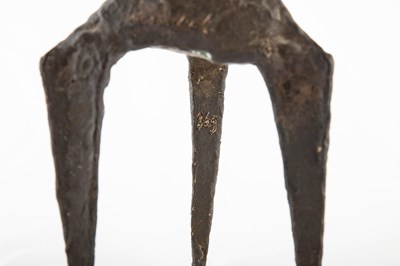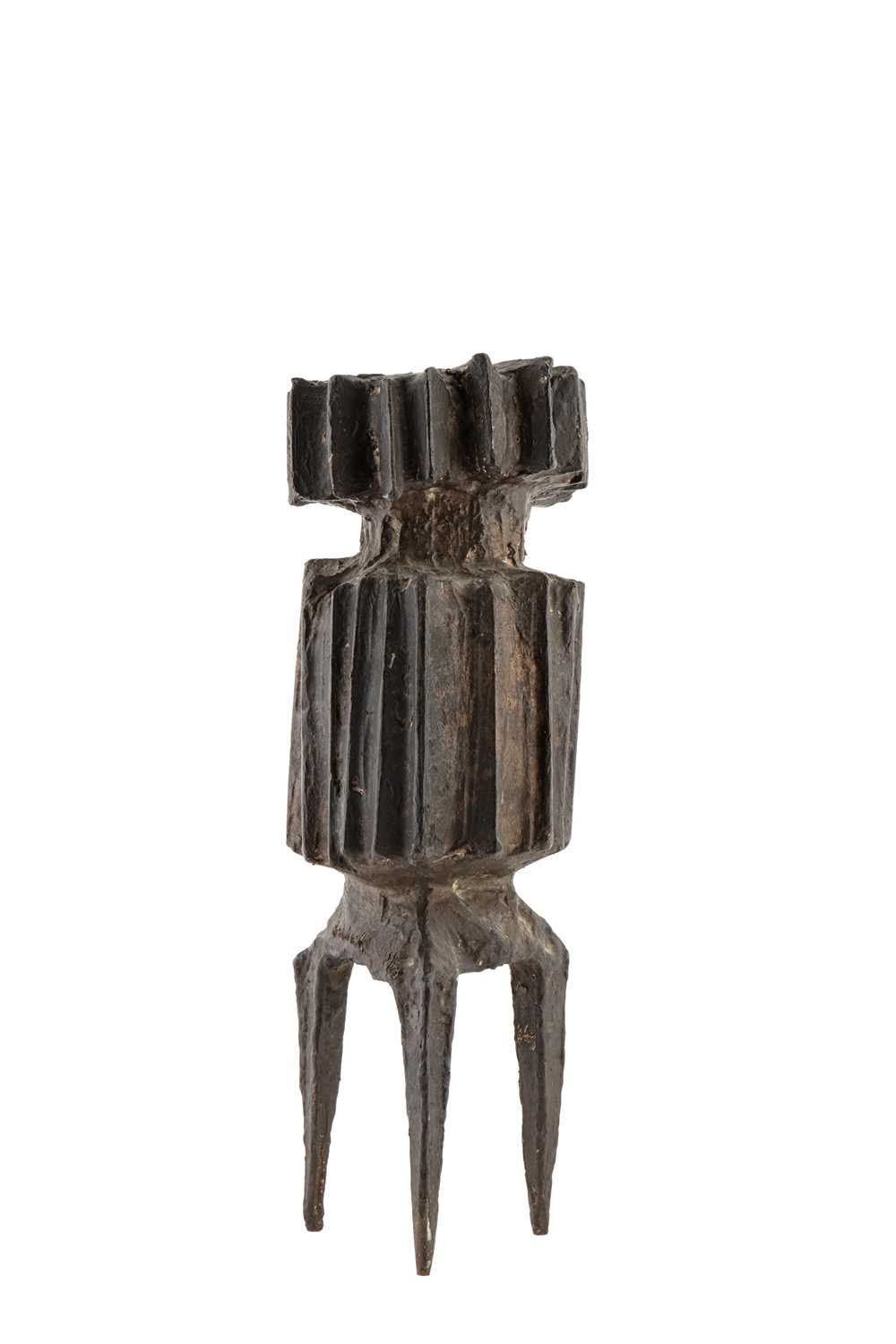13th Dec, 2023 12:00
Fine Paintings, Works on Paper & Sculpture
33
⊕ LYNN CHADWICK (BRITISH 1914-2003)
RAD LAD II
bronze
height: 43cm; 17in
Property from a Private Collection, West London
Executed in 1962 and cast in an edition of 4.
Provenance
Marlborough Fine Art Ltd, London
Purchased from the above by the mother of the present owner 13 August 1965
Exhibited
London, Marlborough Fine Art, Summer Exhibition, 1965, no.13
Literature
Dennis Farr and Éva Chadwick, Lynn Chadwick Sculptor, With a Complete Illustrated Catalogue 1947-2003, London, 2014, p. 198, no. 362 (illustration of the cast in the Museum of Fine Arts, Montreal)
In Rad Lad II a rugged and ridged head and body sit on three angular, tapering legs. Its rough geometric form is half human, half robot. Chadwick's light-hearted title - an abbreviation for 'radiator man' or plumber - refers to the work's corrugated surfaces, but belies the more insidious presence the bronze's spectre-like form suggests. Other more prescient titles he gave to similar sculptures of single figures he completed in the early 1960s included Watcher, Detector and Inquisitor. Such labels of monitoring and surveillance overtly reference the perceived existential threats present in the geo-politics of the day, when the Russian-American Cold War was entrenched, the Cuban Missile crisis was threatening, the Berlin Wall under construction and the horrors of the Vietnam War were unfolding.
Trained as an architectural draughtsman, Chadwick's early forays into sculpture began as mobiles and constructions using materials to hand, in particular sheet metal and steel rods, applying stolit - a mix of gypsum paste and powdered iron - to texture his surfaces. But by the end of the 1950s he had started to cast his work in bronze, as in the present example. Chadwick's interest in casting followed a formidably successful decade of development, beginning with his first solo show at Gimpel Fils in Mayfair in 1950, three separate large scale commissions for the Festival of Britain in 1951 and inclusion both in the Battersea Park Open Air Sculpture Exhibition, and the exhibition American Abstraction in New York the same year. In 1952 he was featured as one of eight young emerging British sculptors in the Venice Biennale, alongside Robert Adams, Kenneth Armitage, Reg Butler, Geoffrey Clarke, Bernard Meadows, Eduardo Paolozzi and William Turnbull. This meteoric rise continued when in 1956 he represented Britain at the Venice Biennale, winning the International Sculpture Prize against the favourite Alberto Giacometti.
RAD LAD II
bronze
height: 43cm; 17in
Property from a Private Collection, West London
Executed in 1962 and cast in an edition of 4.
Provenance
Marlborough Fine Art Ltd, London
Purchased from the above by the mother of the present owner 13 August 1965
Exhibited
London, Marlborough Fine Art, Summer Exhibition, 1965, no.13
Literature
Dennis Farr and Éva Chadwick, Lynn Chadwick Sculptor, With a Complete Illustrated Catalogue 1947-2003, London, 2014, p. 198, no. 362 (illustration of the cast in the Museum of Fine Arts, Montreal)
In Rad Lad II a rugged and ridged head and body sit on three angular, tapering legs. Its rough geometric form is half human, half robot. Chadwick's light-hearted title - an abbreviation for 'radiator man' or plumber - refers to the work's corrugated surfaces, but belies the more insidious presence the bronze's spectre-like form suggests. Other more prescient titles he gave to similar sculptures of single figures he completed in the early 1960s included Watcher, Detector and Inquisitor. Such labels of monitoring and surveillance overtly reference the perceived existential threats present in the geo-politics of the day, when the Russian-American Cold War was entrenched, the Cuban Missile crisis was threatening, the Berlin Wall under construction and the horrors of the Vietnam War were unfolding.
Trained as an architectural draughtsman, Chadwick's early forays into sculpture began as mobiles and constructions using materials to hand, in particular sheet metal and steel rods, applying stolit - a mix of gypsum paste and powdered iron - to texture his surfaces. But by the end of the 1950s he had started to cast his work in bronze, as in the present example. Chadwick's interest in casting followed a formidably successful decade of development, beginning with his first solo show at Gimpel Fils in Mayfair in 1950, three separate large scale commissions for the Festival of Britain in 1951 and inclusion both in the Battersea Park Open Air Sculpture Exhibition, and the exhibition American Abstraction in New York the same year. In 1952 he was featured as one of eight young emerging British sculptors in the Venice Biennale, alongside Robert Adams, Kenneth Armitage, Reg Butler, Geoffrey Clarke, Bernard Meadows, Eduardo Paolozzi and William Turnbull. This meteoric rise continued when in 1956 he represented Britain at the Venice Biennale, winning the International Sculpture Prize against the favourite Alberto Giacometti.
Auction: Fine Paintings, Works on Paper & Sculpture, 13th Dec, 2023
